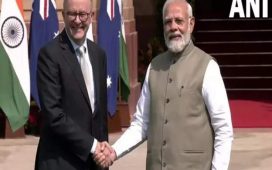Receive free Chinese economy updates
We’ll send you a myFT Daily Digest email rounding up the latest Chinese economy news every morning.
Chinese stocks staged their biggest one day rally since November after a call by China’s leaders for strong “countercyclical” measures to support the world’s second-largest economy, despite what economists said was a lack of detail in Beijing’s plans.
President Xi Jinping’s 24-member politburo, the Communist party’s leading decision-making body, flagged the highly indebted property sector and local governments, as well as lagging domestic demand, at its quarterly meeting on the economy on Monday.
Property stocks in particular soared on Tuesday. But while the overall message was supportive, economists said it provided few details and no sign of the kind of “big bang” stimulus China has implemented in the past. China’s post-Covid recovery lost steam in the second quarter, with growth missing analysts’ expectations.
“It’s a statement of intent providing code words for potentially looser policy settings, but it’s not clear how much muscle will be put behind the stimulus measures,” said Frederic Neumann, chief Asia economist at HSBC.
Xi drops slogan against property speculation
Politburo statement: “The government must adapt to the new situation in which the dynamic of supply and demand in the property market is changing significantly . . . The meeting also urged expanding the supply of government-subsidised housing and renovation of urban villages.”
At the last politburo meeting on the economy in April, which followed more robust first-quarter growth, the readout included the stock Xi Jinping phrase: “Houses are for living in, not for speculation”.
This policy and the government’s desire to curb leverage in the economy are one reason for the deep slowdown in the real estate sector in recent years as banks reduce lending to the industry.
But at Monday’s politburo meeting, the phrase was replaced with more supportive language, acknowledging that “the relationship between supply and demand” in the sector is changing and policies should be “optimised” in a “timely manner”. It said “city-specific” measures should be implemented to better meet “residents’ essential housing demand” and urged the expansion of government-subsidised housing.
This might signal a relaxation of restrictions on home purchases in “Tier-1” cities such as Beijing and Shanghai that were originally imposed to limit speculation. Such a move would “release pent-up demand and stabilise market expectations”, Morgan Stanley economist Robin Xing said in an analyst note.
Tackle local government debt
Politburo statement: “The meeting also urged . . . defusing local government debt risks with a package of plans.”
The politburo hinted at structural reforms to fix local government debt through “a package of debt resolution plans”. Local government’s colossal debts — including those of local government finance vehicles — are estimated by Goldman Sachs at about Rmb94tn ($13.1tn), and are seen as a constraint on growth.
The guidance, which provided few details, indicates that despite the economic slowdown Beijing remains keen to stick with the policy of debt reduction outlined in the last meeting in April.
“It means that local debt resolution has entered a critical period,” said Zhong Zhengsheng, chief economist of Ping An Securities. The government was unlikely to offer massive debt swaps as it did in 2015, Zhong said, as this would only increase leverage. It might instead tackle the problem province by province, he said.
“We expect state and policy banks to take on a more active role in resolving these debt risks at the local government level,” said Louise Loo, lead economist at Oxford Economics.
Make employment a high priority
Politburo statement: “It is necessary to increase the protection of people’s livelihood . . . and raise the issue of stabilising employment to a strategic height.”
With youth unemployment in China hitting 21.3 per cent in June — the highest since the data series began in 2018, the politburo underlined the need to tackle employment.
The politburo did not say what it planned to do to reduce unemployment, which economists attributed to a shortage of suitable jobs for this year’s record number of graduates and the damage to the services sector from the pandemic.
But in a move that could help create jobs, Beijing pledged to “optimise” the environment for private enterprises and spur foreign investment. “We see this as a part of the government’s efforts to restore private confidence and revive animal spirits, a key to sustaining productivity growth amid secular challenges from demographics, debt and de-risking,” Morgan Stanley said.
Get people spending again
Politburo statement: “The meeting also . . . called for precise and effective control of macroeconomic measures, including proactive fiscal and prudent monetary policies.”
The party leaders indicated that monetary and fiscal policy would remain supportive but provided no figures and few details. The government has already eased policy interest rates, cut its bank reserve requirement ratio to introduce more liquidity into the system, and provided some tax breaks to businesses.
Economists forecast small rate cuts before the end of the year and another RRR cut by 25 to 50 basis points. “Broadly the language around monetary policy is similar in the July statement compared to April,” said Oxford Economics’ Loo. “So we do not expect major loosening in this area.”
The government is also expected to roll out subsidies for consumers to buy more cars, electronics and home appliances, helping the industry to clear inventories built up last year and step up manufacturing.
Keeping recovery on track without much stimulus
Politburo statement: “The meeting called for carrying out macroeconomic regulation with precision and force, stepping up countercyclical measures, and making more policy options available.”
Overall, economists believe that the government wants to ensure it meets its growth target of 5 per cent for 2023, without racking up another huge wave of debt-fuelled stimulus in the process.
In recent weeks, the government has announced at least four separate plans aimed at everything from attracting more private capital to boosting electric vehicle ownership and the purchase of consumer goods, according to a note by Carlos Casanova, senior economist at UBP. The measures should “result in a broadening of the economic recovery”, he said.
This year’s growth has been flattered by the negative impact of Covid lockdowns on activity in 2022. The tricky part might be ensuring a reasonable level of growth into 2024, when the economy will not benefit from a low base effect, economists say.
Already economists are looking towards the third plenum of the 20th party congress, a key meeting later this year for more details of the government’s medium-term plans, economists say. “The third plenum in the fall should be an opportunity to think about the structural issues,” said HSBC’s Neumann.










